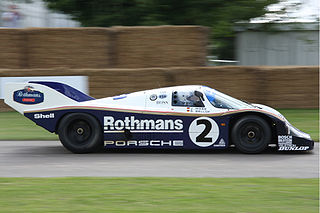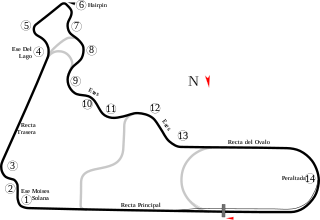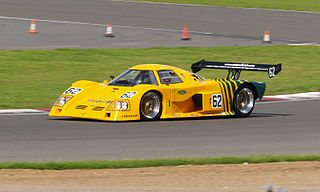
The Sauber C9 is a Group C prototype race car introduced in 1987 as a continuation of the partnership between Sauber as a constructor and Mercedes-Benz as an engine builder for the World Sportscar Championship. The C9 replaced the Sauber C8.

The Porsche 956 was a Group C sports-prototype racing car designed by Norbert Singer and built by Porsche in 1982 for the FIA World Sportscar Championship. It was later upgraded to the 956B in 1984. In 1983, driven by Stefan Bellof, this car established a record that would stand for 35 years, lapping the famed 20.832 km (12.93 mi) Nürburgring Nordschleife in 6:11.13 during qualifying for the 1000 km Sports Car race. The record was finally surpassed by Timo Bernhard in a derestricted Porsche 919 Evo on 29 June 2018.

The Porsche 962 is a sports-prototype racing car built by Porsche as a replacement for the 956 and designed mainly to comply with IMSA's GTP regulations, although it would later compete in the European Group C formula as the 956 had. The 962 was introduced at the end of 1984, from which it quickly became successful through private owners while having a remarkably long-lived career, with some examples still proving competitive into the mid-1990s. The vehicle was later replaced by the Porsche WSC-95.

The World Sportscar Championship was the world series run for sports car racing by the FIA from 1953 to 1992.
Max Welti is a former Swiss racing driver, Sauber's first team manager and thus double winner of the 24 Hours of Le Mans as well as two-time sports car world champion with Sauber Mercedes. Five years later, he wins the 24 Hours of Le Mans for a second time with Porsche as the responsible race director. He then returns to Sauber as overall manager of the Sauber Formula One operation. In 2000 Welti becomes CEO of the European silhouette touring car racing series "V8STAR" before becoming team owner of A1 A1 Team Switzerland in 2005. As an international motorsport strategist and consultant, Welti nowadays works for OEMs, promoters and organisers.
Joest Racing is a sports car racing team that was established in 1978 by former Porsche works racer Reinhold Joest. Their headquarters are in Wald-Michelbach, Germany.

The Sauber SHS C6 was a Group C prototype racing car built by Swiss manufacturer Sauber and engineering firm Seger & Hoffman, intended for competition in the World Endurance Championship and Deutsche Rennsport Meisterschaft series. Seger & Hoffman left the project later in 1982, leaving the car completely under Sauber's control.

Porsche has been successful in many branches of motorsport of which most have been in long-distance races.

Brun Motorsport GmbH was a Swiss auto racing team founded by driver Walter Brun in 1983. They competed as a Porsche privateer team in sports car racing for their entire existence, running in a multitude of international championships. They notably won the World Sportscar Championship in 1986 and later became a full-fledged chassis constructor. Brun was also briefly part of the EuroBrun Formula One team from 1988 to 1990. The team was eventually dissolved in 1992.

The Lancia LC2 was a series of racing cars built by Italian automobile manufacturer Lancia and powered by engines built by their sister company Ferrari. They were part of Lancia's official factory-backed effort in the World Sportscar Championship from 1983 to 1986, although they continued to be used by privateer teams until 1991. They were also the company's first car meeting the FIA's new Group C regulations for sports prototypes.
Richard Lloyd Racing (RLR), originally named GTi Engineering, was a British auto racing team created in 1977 by driver Richard Lloyd. Originally named for the Volkswagen Golf GTIs that Lloyd raced in the British Saloon Car Championship (BSCC), they went on to become a successful Porsche privateer in the World Sportscar Championship (WSC). Richard Lloyd Racing eventually folded at the end of the 1990 season due to the increased cost of the World Championship.

The 1988 Lucas Supersprint was the eleventh and final round of the 1988 World Sports-Prototype Championship. It took place at Sandown Raceway, Victoria, Australia on 20 November 1988.

The 1989 Trofeo Hermanos Rodríguez was the eighth and final round of the 1989 World Sportscar Championship season. It took place at the Autódromo Hermanos Rodríguez, Mexico on October 29, 1989.
Dauer Sportwagen GmbH was a German automotive company founded by former racing driver Jochen Dauer in Nuremberg. Initially founded as Jochen Dauer Racing in 1987, the racing team had several years of participation in the German Supercup and European Interserie championships, as well as occasional runs in the World Sports-Prototype Championship and Camel GT Championships with the Porsche 962. Following the demise of sports prototype racing in the early 1990s, Dauer Racing GmbH was created to begin limited production of road cars, including a road-legal version of the 962, known as the Dauer 962 Le Mans, which later went on to win the 1994 24 Hours of Le Mans. Once changing to Dauer Sportwagen, the company sold a continuation of the Bugatti EB110. The company went bankrupt in 2008 and parts for the EB110 were transferred to Toscana-Motors GmbH.

The 1987 200 Meilen von Nürnberg was the sixth round of the 1987 World Sports-Prototype Championship, known as the ADAC Norisring Trophäe, as well as the second round of the 1987 German Supercup, known as the Bilstein Cup. It took place at the Norisring temporary street circuit, West Germany on June 28, 1987.

The 1986 ADAC Kouros 1000 km Nürburgring was the seventh round of the 1986 World Sports-Prototype Championship. It took place at the Nürburgring, West Germany on August 24, 1986.
Olaf Manthey is a German former race car driver, and current owner of Porsche team Manthey Racing.

Mike Rockenfeller, nicknamed "Rocky", is a German professional racing driver, currently an Audi factory driver competing in the DTM. He won his first DTM title in 2013, driving for Audi Sport Team Phoenix.

The Ford C100 is a sports racing car, initially built and run as a Group 6 car, but later as a Group C car. The C100 was built by Ford in 1981, and initially featured a 4-litre Cosworth DFL V8 engine, which was replaced by a 3.3-litre version of the same engine in 1983, after the car had passed to private hands. Five cars are known to have been built. Although the cars were often very quick in qualifying, reliability problems plagued them, and restricted their successes to two Deutsche Rennsport Meisterschaft victories in 1982, and a single Thundersports victory in 1983.

Willibert "Willi" Kauhsen is a German former racing driver and racing team owner from Eschweiler in Aachen, Germany.














